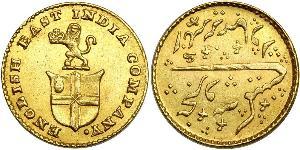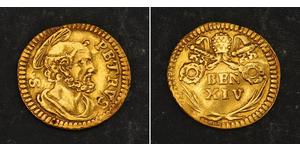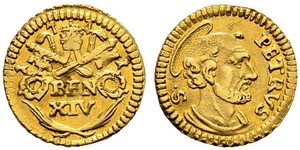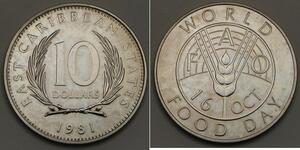1 Rupee India Silver
India, Baroda State, Sayaji Rao III. Milled Silver “Portrait” Rupee Coin.
Reference: KM-36a.
Denomination: Rupee
Mint Period: 1896 (VS 1953)
Weight: 11.39gm
Diameter: 28mm
Material: Silver
Baroda State was a state in present-day Gujarat, ruled by the Gaekwad dynasty of the Maratha Confederacy from its formation in 1721 until 1949 when it acceded to the newly formed Union of India. With the city of Baroda (Vadodara) as its capital, during the British Raj its relations with the British were managed by the Baroda Residency. At the time of Indian independence, only five rulers—the Nizam of Hyderabad, the Maharaja of Mysore, the Maharaja of Jammu and Kashmir, the Maharaja Shrimant Gaekwar of Baroda and the Maharaja Scindia of Gwalior—were entitled to a 21-gun salute. Baroda formally acceded to the Union of India, on 1 May 1949, prior to which an interim government was formed in the state.
Sayajirao Gaekwad III (born Shrimant Gopalrao Gaekwad, 11 March 1863 – 6 February 1939) was the Maharaja of Baroda State from 1875 to 1939, and is notably remembered for reforming much of his state during his rule. He belonged to the royal Gaekwad dynasty of the Marathas which ruled parts of present-day Gujarat.
Sayajirao was born in a Maratha family at Kavlana in Malegaon Tahsil Dist. Nashik as Shrimant Gopalrao Gaekwad, second son of Meherban Shrimant Kashirao Bhikajirao Dada SahibGaekwad (1832–1877) and Shrimant Akhand Soubhagyavati Ummabai Sahib. His branch of the Gaekwad dynasty was a cadet branch descended from a morganatic marriage of the first Raja of Baroda and so was not expected to succeed to the throne.
Following the death of Sir Khanderao Gaekwad (1828–1870), the popular Maharaja of Baroda, in 1870, it was expected that his brother, Malharrao (1831–1882), would succeed him. However, Malharrao had already proven himself to be of the vilest character and had been imprisoned earlier for conspiring to assassinate Khanderao. As Khanderao’s widow, Maharani Jamnabai (1853–1898) was already pregnant with a posthumous child, the succession was delayed until the gender of the child could be proven. The child proved to be a daughter, and so upon her birth on 5 July 1871, Malharrao ascended the throne.
Malharrao spent money liberally, nearly emptying the Baroda coffers (he commissioned a pair of solid gold cannon and a carpet of pearls, among other expenses) and soon reports reached the Resident Robert Phayre of Malharrao’s gross tyranny and cruelty. Malharrao further attempted to cover up his deeds by attempting to poison the Resident with a compound of arsenic. By order of the Secretary of State for India, Lord Salisbury, Malharrao was deposed on 10 April 1875 and exiled to Madras, where he died in obscurity in 1882.
With the throne of Baroda now vacant, Maharani Jamnabai called on the heads of the extended branches of the dynasty to come to Baroda and present themselves and their sons in order to decide upon a successor.
Kashirao and his three sons, Anandrao (1857–1917), Gopalrao (1863–1938) and Sampatrao (1865–1934) walked to Baroda from Kavlana a distance of some 600 kilometers to present themselves to Jamnabai. It is reported that when each son was asked the purported reason for presenting themselves at Baroda, Gopalrao unhesitatingly stated:
“I have come here to rule”.
He was selected by the British Government as successor and was accordingly adopted by Maharani Jamnabai, on 27 May 1875. He was also given a new name, Sayajirao. He ascended the gadi (throne) at Baroda, 16 June 1875 but being a minor reigned under a Council of Regency until he came of age and was invested with full ruling powers on 28 December 1881. During his minority he was extensively tutored in administrative skills by Raja Sir T. Madhava Rao who groomed his young protégé into being a person with foresight and with a will to provide welfare to his people. In this period Madhava Rao restored the state to its normal conditions following the chaos in which it had been left by Malharrao. Not a little credit for what the Maharaja achieved during his life in every sphere of human activity must be given to F. A. H. Elliot.
On assuming the reins of government, some of his first tasks included education of his subjects, uplifting of the downtrodden, and judicial, agricultural and social reforms. He played a key role in the development of Baroda’s textile industry, and his educational and social reforms included among others, a ban on child marriage, legislation of divorce, removal of untouchability, spread of education, development of Sanskrit, ideological studies and religious education as well as the encouragement of the fine arts.
His economic development initiatives included the establishment of a railroad (see below) and the founding in 1908 of the Bank of Baroda, which still exists and is one of India’s leading banks, with numerous operations abroad in support of the Gujarati diaspora.
Fully aware of the fact that he was a Maratha ruler of Gujarat, he identified himself with the people and shaped their cosmopolitan attitude and progressive, reformist zeal. His rich library became the nucleus of today’s Central Library of Baroda with a network of libraries in all the towns and villages in his state. He was the first Indian ruler to introduce, in 1906, compulsory and free primary education in his state, placing his territory far in advance of contemporary British India.
To commemorate his vision and administrative skills, Baroda Management Association has instituted Sayaji Ratna Award in 2013, named after him.
Though a prince of a native state, he guarded his rights and status even at the cost of annoyance to the British Indian Government. Sayajirao was often in conflict with the British on matters of principle and governance, having continuous and longstanding verbal and written disputes with the British Residents as well as with the Viceroy and officials in the Government of India. He was granted the title of Farzand-i-Khas-i-Daulat-i-Inglishia on 29 December 1876. He attended the Delhi Durbars of 1877, 1903 and 1911; it was at the 1911 Delhi Durbar that an incident occurred that proved to have far-reaching ramifications for Sayajirao’s relations with the Raj.
(1537 X 753 pixels, file size: ~239K)
Posted by: anonymous 2019-07-12
1892, India, Baroda State, Sayaji Rao III. Scarce Silver Rupee Coin. F-VF! Condition: F-VF! Denomination: Rupee Mint Period: 1892 (VS 1949) Reference: KM-36 ($125 in F!). Weight: 11.23gm Diameter: 30mm Material: Silver Baroda State was a state in present-day Gujarat, ruled by th ...
(1537 X 741 pixels, file size: ~222K)
Posted by: anonymous 2019-07-12
1894, India, Baroda State, Sayaji Rao III. Beautiful Silver Rupee Coin. XF-AU! Condition: XF-AU! Denomination: Rupee Mint Period: 1894 (VS 1951) Reference: KM-36a ($140 in XF!). Weight: 11.33gm Diameter: 28mm Material: Silver Baroda State was a state in present-day Gujarat, ...
(3205 X 1558 pixels, file size: ~1M)
Posted by: anonymous 2024-08-28
1896, India, Baroda State, Sayaji Rao III. Milled Silver "Portrait" Rupee Coin. R! Condition: XF!Reference: KM-36a. Denomination: Rupee Mint Period: 1896 (VS 1953) Weight: 11.39gm Diameter: 28mm Material: Silver Baroda State was a state in present-day Gujarat, ruled by the Gaekwad dynas ...
(1200 X 593 pixels, file size: ~200K)
Posted by: anonymous 2015-09-04
† Coins of India. Princely States. Baroda, Sayaji Rao III (AH 1292-1357; VS 1932-1995; 1875-1938 AD), Silver Rupees (9), AH 1292, AH 1293 (2), AH 1295, AH 1297, AH 1298 (2), AH 1300, AH 1301; Silver ½-Rupees (3), AH 1292, AH 1292 or 3, AH 1302; Silver ⅛ -Rupee (KM Y29, 28, 26); Milled Silver Ru ...
(1200 X 591 pixels, file size: ~229K)
Posted by: anonymous 2015-08-23
† Å KE LIND É N COLLECTION, INDIAN, PRINCELY STATES AND INDEPENDENT KINGDOMS Baroda, Sayaji Rao III, Milled Coinage, Silver Rupees (2), VS 1949, VS 1952 (KM Y36, Y36a), ½-Rupees (2), VS 1948, VS 1949 (KM Y35, Y35a for type), 4-Annas (2), VS 1949, VS 1951 (KM Y34, Y34a), 2-Annas (2), VS 1949, VS ...
1/2 Scudo Vatican Gold
group has 5 coins / 5 prices
⇑
One of them is





















